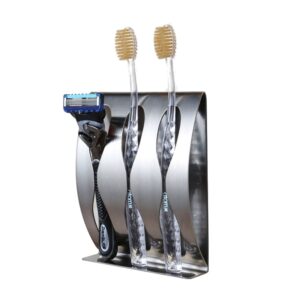
Cleaning and maintaining your toothbrush holder is an essential part of maintaining good oral hygiene and overall cleanliness in your bathroom. Toothbrush holders can easily become breeding grounds for bacteria and germs if not cleaned regularly.
Step 1: Remove All Toothbrushes
The first step in cleaning your toothbrush holder is to remove all toothbrushes from the holder. This will allow you to thoroughly clean and sanitize the holder without any obstructions.
Make sure to also check the bottom of the holder for any debris or dirt that may have accumulated. The bottom of a toothbrush holder can be a prime spot for bacteria and germs to grow, so it is essential to check this area and clean it thoroughly.
Step 2: Wash with Soap and Water
Once all toothbrushes have been removed, wash the toothbrush holder with soap and water. Use a soft-bristled brush or sponge to scrub the inside and outside of the holder.
Make sure to pay special attention to any crevices or hard-to-reach areas where bacteria and germs may be hiding. These areas can be difficult to clean, but it is important to be thorough in order to ensure the holder is properly sanitized.
Step 3: Rinse Thoroughly
After washing the toothbrush holder with soap and water, rinse it thoroughly with warm water. Make sure to remove all soap residue and debris from the holder.
Rinsing the holder is an essential step in the cleaning process, as it will remove any remaining dirt or bacteria that may have been missed during the washing stage.
Step 4: Sanitize with Vinegar
To effectively kill bacteria and germs, it is important to sanitize your toothbrush holder regularly. One effective and natural way to do this is to use vinegar.
Fill a bowl with equal parts vinegar and water, and soak the toothbrush holder in the solution for at least 30 minutes. After soaking, rinse the holder thoroughly with warm water.
Vinegar is a natural disinfectant that is effective at killing bacteria and germs. It is also safe to use and does not contain any harsh chemicals that could damage your toothbrush holder.
Step 5: Allow to Dry
Once the toothbrush holder has been washed, rinsed, and sanitized, allow it to dry completely before replacing the toothbrushes. Damp or wet toothbrush holders can promote the growth of bacteria and mold.
It is best to air-dry the holder by placing it in a well-ventilated area, or by using a towel to dry it off. Avoid using a hair dryer or other heat source to dry the holder, as this could cause damage to the holder or create a fire hazard.
Additional Tips for Maintaining Your Toothbrush Holder
In addition to regular cleaning and sanitizing, there are several other steps you can take to maintain your toothbrush holder and promote good oral hygiene.
Replace Your Toothbrush Holder Regularly
Even with regular cleaning and maintenance, toothbrush holders can become worn, cracked, or stained over time. It is important to replace your toothbrush holder regularly to ensure that it remains clean and hygienic.
If you notice any signs of wear or damage to your toothbrush holder, it is best to replace it immediately. A damaged toothbrush holder can harbor bacteria and germs, which can lead to oral health problems and illness.
Store Toothbrushes with Bristles Up
When storing toothbrushes in a holder, make sure to store them with the bristles facing up. This will allow them to dry completely and prevent moisture from accumulating in the base of the holder.
Moisture can promote the growth of bacteria and mold, which can lead to oral health problems and illness. By storing your toothbrushes with the bristles facing up, you can ensure that they remain dry and clean between uses.
Avoid Sharing Toothbrush Holders
While it may be convenient to share a toothbrush holder with others, it is best to avoid doing so. Sharing toothbrush holders can lead to the spread of bacteria and germs, and can increase the risk of infection and illness.
If you live with roommates or family members, it is best to use separate toothbrush holders to avoid cross-contamination. This will help to ensure that everyone maintains good oral hygiene and stays healthy.
Clean Toothbrushes Regularly
In addition to cleaning your toothbrush holder, it is important to also clean your toothbrushes regularly. Rinse them thoroughly with warm water after each use, and sanitize them with vinegar or another natural disinfectant at least once a week.
Regularly cleaning your toothbrushes is essential for maintaining good oral hygiene and preventing the spread of bacteria and germs. Make sure to also replace your toothbrushes every three to four months, or sooner if the bristles become frayed or damaged.